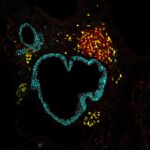
Publication: TLR3 deficiency in patients with herpes simplex encephalitis.
Publié dans: Science, 2007, 317 (5844), pp.1522-7. ⟨10.1126/science.1139522⟩
Auteurs: Shen-Ying Zhang, Emmanuelle Jouanguy, Sophie Ugolini, Asma Smahi, Gaëlle Elain, Pedro Romero, David Segal, Vanessa Sancho-Shimizu, Lazaro Lorenzo, Anne Puel, Capucine Picard, Ariane Chapgier, Sabine Plancoulaine, Matthias Titeux, Céline Cognet, Horst von Bernuth, Cheng-Lung Ku, Armanda Casrouge, Xin-Xin Zhang, Luis Barreiro, Joshua Leonard, Claire Hamilton, Pierre Lebon, Bénédicte Héron, Louis Vallée, Lluis Quintana-Murci, Alain Hovnanian, Flore Rozenberg, Eric Vivier, Frédéric Geissmann, Marc Tardieu, Laurent Abel, Jean-Laurent Casanova
Résumé
Some Toll and Toll-like receptors (TLRs) provide immunity to experimental infections in animal models, but their contribution to host defense in natural ecosystems is unknown. We report a dominant-negative TLR3 allele in otherwise healthy children with herpes simplex virus 1 (HSV-1) encephalitis. TLR3 is expressed in the central nervous system (CNS), where it is required to control HSV-1, which spreads from the epithelium to the CNS via cranial nerves. TLR3 is also expressed in epithelial and dendritic cells, which apparently use TLR3-independent pathways to prevent further dissemination of HSV-1 and to provide resistance to other pathogens in TLR3-deficient patients. Human TLR3 appears to be redundant in host defense to most microbes but is vital for natural immunity to HSV-1 in the CNS, which suggests that neurotropic viruses have contributed to the evolutionary maintenance of TLR3.
Lien vers Pubmed [PMID] – 17872438
Lien vers HAL – hal-00297308
Lien vers le DOI – 10.1126/science.1139522


